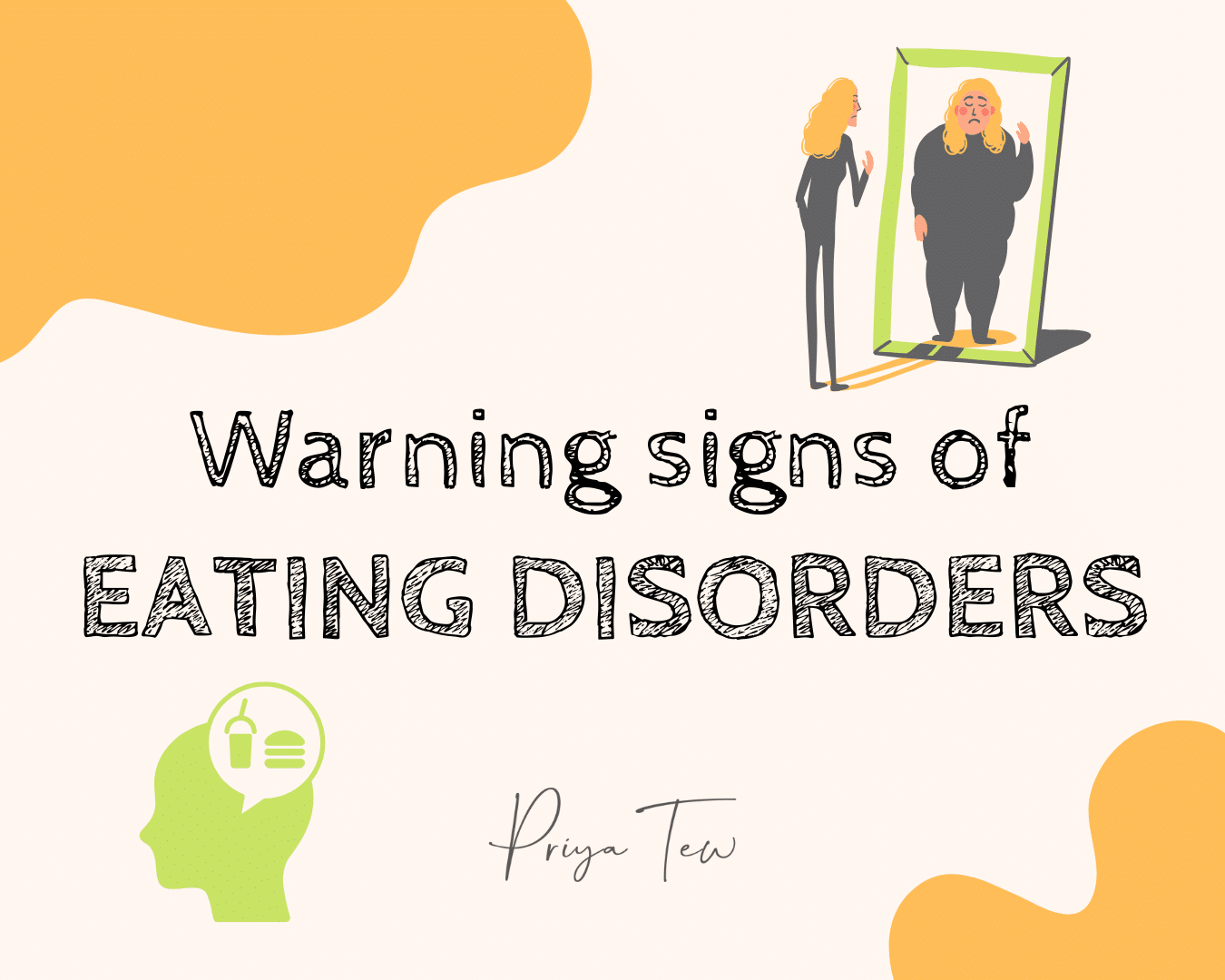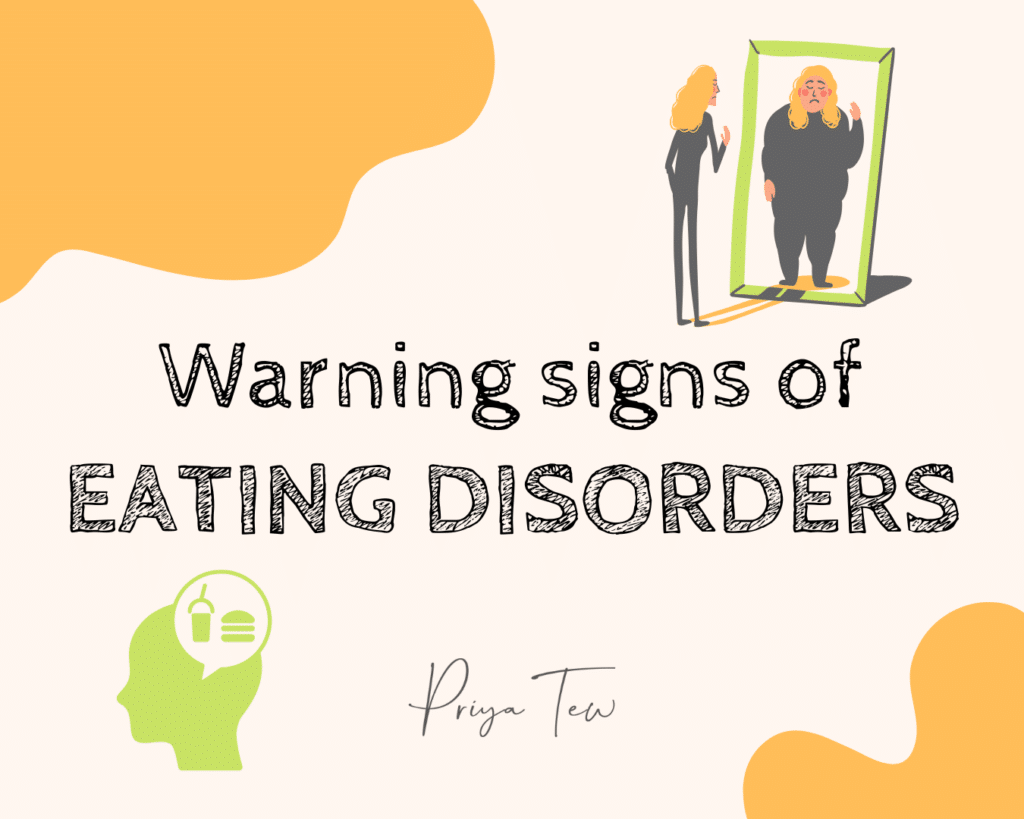
Knowing the warning signs of an eating disorder can be vital and lead to someone getting help. Personally I think knowing the signs and symptoms of eating disorders is something everyone needs to know. Any health care professional, teacher, sports coach, parent, friend and family member could be the person who spots a problem and starts that person on the journey to healing. So where do start?
There are many different forms of eating disorders and they can have a broad range of symptoms. Knowing what warning signs to look out for can help you to recognise when a loved one might need support. Some symptoms might only be noticeable to a healthcare professional or the individual. However, lots of these symptoms are thigns you you may pick up on, for example changes to behaviour, mood or some physical symptoms.

Anorexia nervosa warning signs
Classically, we think of the restricting type of anorexia, an illness where people can lose weight, often to dangerous levels, by restricting their food and drink. However often this may not be the case. People can also be suffering and be of a normal weight or they may have lost some weight but this maybe hasn’t been flagged up as being to dangerous levels. I’d like to point out that weight is not always the best benchmark.
Other warning signs of anorexia can involve strict food rules, cutting out food groups and overexercising. Being unable to eat out and needing complete control over how food is prepared is another sign you may see.
It is also important to know that not everyone with anorexia will only be restricting food. People with anorexia may also show some compensatory behaviours that overlap with bulimia, such as vomiting.
Symptoms of anorexia:
- Being hyperfocused on body weight, size, and shape.
- Having a low self-worth or distorted body image.
- An intense fear of being overweight or gaining body fat and weight.
- Obsessed with tracking, learning about food and nutrition.
- Refusing to eat with or be seen eating by others.
- Increased emotional dysregulation (irritability, mood swings, etc).
- Difficulty thinking and focusing as well as rigid thinking, sometimes called black and white thinking.
- Meal skipping or cutting out whole food groups and anxiety eating certain foods.
- Frequent weighing and body checking in the mirror/feeling a body area.
- Low self esteem and body image issues.
Bulimia Nervosa warning signs
In bulimia, there is usually a cycle of uncontrolled overeating (called bingeing) followed by purging behaviours. Purges are often thought of as vomiting, although can involve misuse of laxatives or other behaviours. People with bulimia may not show as much, or any weight loss as someone with anorexia.
Often we mis-use the word binge, almost as a form of slang for when we eat more than usual. However binges are not just over-eating, they involve a loss of control around food and eating vast amounts of food in a short period of time. Binges involve the consumption of more calories than are lost during purging behaviours.
Bulimia signs may also cause damage to the throat, fingers and teeth due to vomiting. Some people will suffer with very uncomfortable acid reflux as a result of the purging too.
Bulimia Signs:
- Disappearing after eating (in order to purge)
- Eating large amounts of food
- Acting secretive around food or hiding eating
- Organising life around food and eating opportunities
- Hoarding food
- Reporting feeling a loss of control around food
- Feelings of guilt around eating behaviours
- Bloating and stomach pain
- Facial swelling known as Bulimia cheeks
Warning signs of Binge Eating Disorder
Like bulimia, binge eating disorder (BED) is characterised by (as the name suggests), bingeing episodes. However, it is not associated with purging behaviours. Although BED is less spoken about compared to bulimia and anorexia, it is one of the most common forms of eating disorders. It is also more likely to be seen in adults.
Signs of binge eating disorder:
- Buying or hoarding large amounts of food
- Eating rapidly and outside of hunger cues
- Organising life around food and eating opportunities
- Avoiding eating around others
- Weight gain and bloating
- Issues sleeping
- Poor skin
Avoidant/Restrictive Food Intake Disorder
In avoidant restrictive food intake disorder (ARFID), people may avoid certain types of foods, leading to a restriction in the variety of food, or total calorie intake -or often both. This is sometimes known as extreme fussy eating. People can struggle to eat certain colours, textures and be very brand specific with food. ARFID is a condition that really needs a specialist feeding team and it is key to treat it quickly, especially in children who are still growing.
ARFID is not typically associated with a desire to control or change weight. Although ARFID can occur at any age, it can occur as early as two years old. ARFID may co-occur with autism, ADHD and anxiety disorders.
Signs of ARFID:
- Sudden refusal to eat
- Fear of choking
- “Picky” behaviour around food
- Only eating foods with certain textures, or requiring food to be prepared in a particular way
- Delayed growth in children or young adults, or weight loss in adults and older teenagers
- Weight gain where food choices are limited to higher-calorie options
Diabulimia Warning Signs
Diabulimia is a less-known eating disorder that occurs in people with diabetes and use insulin, most typically type 1 diabetes. It can also be referred to as Type 1 Disordered Eating (T1DE). People with this condition may restrict their insulin intake in order to lose weight. This can be extremely dangerous. Symptoms to look out for include:
- Being seen to not use insulin at the proper dosage and frequency
- Secretiveness about eating habits and use of insulin
- Sudden weight loss
- A1c of 9.0% or higher
- Increased thirst or need to urinate
- Multiple diabetes-related ketoacidosis (DKA) episodes or near-DKA episodes
Orthorexia vs Anorexia:
Although orthorexia isn’t formally classified as an eating disorder, it is a type of disordered eating behaviours associated with an obsession with only eating healthy foods. This is similar to anorexia as the emphasis is on weight, shape and restricting foods. However where it differs to anorexia is in the way it develops
The definition of healthy can vary from one person to the next, but may become increasingly restrictive over time.
Symptoms of Orthorexia
- Food obsession and preoccupation
- Extreme food and dietary rules
- Avoiding whole food groups
- Viewing food in very black and white ways -either good or bad
- Avoidance of social eating settings
- Anxiety, mood swings and emotional distress
- Judging others’ food choices
- Exercise obsession
Other Specified Feeding and Eating Disorder
Where someone’s symptoms don’t meet the requirements of a particular eating disorder, they may be categorised as having Other Specified Feeding and Eating Disorder (OSFED). This can include anorexia without weight loss, bulimia or BED or a low frequency or limited duration, or symptoms that fit into two or more categories of eating disorders.
Warning signs may look similar to some of the signs and symptoms described above. If you recognise these signs in a loved one, they may benefit from speaking with their GP or eating disorder specialist dietitian or psychologist.
Seeking support and treatment options
If a loved one is showing some of the warning signs of an eating disorder it is very important to get them help as soon as possible. This can be so tricky as they may not acknowledge there is a problem or feel ready to tackle it. Lots of support from family and friends reinforcing how valued they are as a person and why you are concerned may help. BEAT eating disorders has resources or how to do this. Seeing a GP or your doctor for a physcial review and for advice is the number one step. Then you can build your support team which may include a dietitian, therapist and medical support. If you need any dietetic support then please get in touch, you can also speak to me about booking a dietitian consultation.
